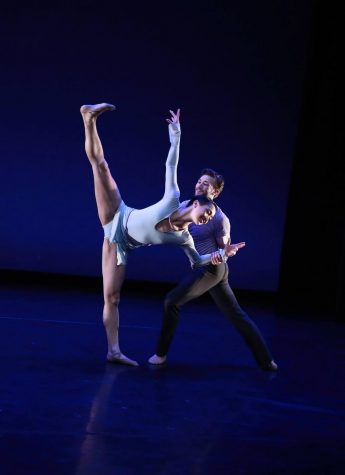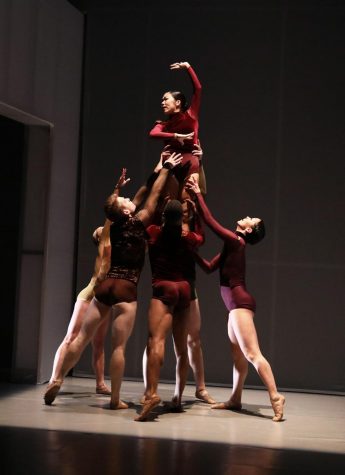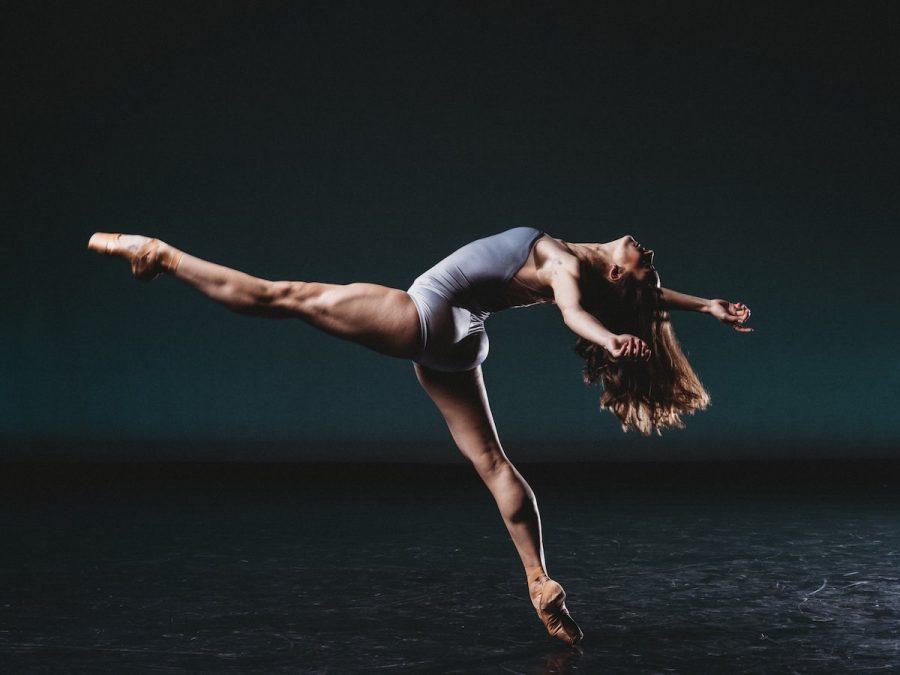To push boundaries is to challenge convention, and challenging convention is what BalletX aims to do. The Philadelphia-based contemporary ballet company performed at the UMass Fine Arts Center on Thursday, March 29. Directed by Christine Cox and Pioneer Valley native Tara Keating, BalletX presents a trio of works created by innovative and insightful choreographers performed by a company of 10 talented dancers. The result is a palette of emotion conveyed through both the inspirational athleticism and gentle nuances of the body.
Opening piece “Gran Partita,” meaning “great game” in Italian, is the work of prominent choreographer Jorma Elo, current resident choreographer at Boston Ballet. The flavor of this piece is distinctly contemporary ballet, complete with the minimalistic nude leotard and dynamic choreography set to classical music (in this instance, excerpts by Berg, Monteverdi, Mozart and Bach). That being said, there is clearly more to it than the simplistic variety of most contemporary ballets.
“Gran Partita” also delivers in musicality. Setting steps to the beat of a music is easy enough—a tap of the foot with a staccato rhythm, a leap as the notes surge high—but it is just as easy for the embellishments to become flat, and “Gran Partita” delivers. Elo and the BalletX dancers avoid mimicking movement to music; instead, they build on the auditory narrative of the music, each step intentional and meaningful. In fact, the collaboration with tempo is a notable strength of “Gran Partita.” There are delectable nuggets of timing scattered throughout: a sharp, exact pirouette dissolving into its landing with a teasing stretch of a torso, a decisive turn of the head to highlight a trill in the music and the swift but unhurried fluidity of dancers exiting and entering the stage. As in a game, dancers play with the music with a well-honed elasticity as they teeter on the edge of wire-strung snappiness and sweeping reaches.
As its name would suggest, the artistic offerings of “On The Mysterious Properties of Light”
display a spectrum of musical styles and attitudes. From thrumming electro-synth to raucous Beijing opera-style music to the guttural beat of West Asian throat singing, “On The Mysterious Properties of Light” presents attitudes of this “mundane yet miraculous” stream of particles. Choreographer Colby Damon shares his ceaseless curiosity in the form of equally diverse dancing styles, or without “dancing” at all. The most novel part of this piece had to be the monologue (yes, monologue) accompanied by interpreted movements. One performer wearing business-casual garb gives a speech on the confounding, captivating properties of light while another dances. She molds her arms, twirls, runs in circles in complement to what he narrates, the both of them moving in unison every so often to movement with words. Although they perform most of the time from opposite sides of the stage, they are hardly distanced. Rather, they are spatially and intellectually connected with one another, adding laughs when they interact. This persists, humorously and shrewdly, with ensembles and partnered duets. In several moments, the rest of the cast poke their heads out from the curtains of the wings and say a fact about light in unison. There is a special kind of delight in this piece, and an unexpected twist that adds uniqueness to the night’s lineup.
It’s not that “On The Mysterious Properties of Light” doesn’t take itself seriously—it’s evident through the clever use of partnering and spry movements that it is indeed a work of dance, and a great one at that. However, it’s refreshing to see dance that explores other genres, such as comedy, and acknowledges the audience (even if it has to smash the fourth wall) and their desire to learn from spectating dance.

Part of BalletX’s mission is to “challenge the boundaries of classical ballet,” and that becomes exhilaratingly clear as the night ends with Trey McIntyre’s “Big Ones.” Entirely set to select tracks from Amy Winehouse’s “Frank” and “Back to Black” albums, McIntyre melds the souls of the music’s and dancing’s defiance, sweetness and mischief.
Sassy sing-along “Rehab” kicks off this final piece, but not before a quirky, head-cock-inducing opening. Nine headpieces, only roughly describable as ridiculously long, streamlined rabbit ears, line the back of the stage on stands. A solo dancer picks one up, fastens it to her head (adding yet another oddity to her gleaming black latex costume), and begins her dance to Winehouse’s bluesy, rough-edged crooning. Later, the other performers come onto the stage to don their headgear, and the wonderful weirdness continues.
“F*** Me Pumps” oozes with attitude as three dancers sashay on stage, enticing the audience to watch their hips as much as they do the rest of their bodies. Their point work does not clash with the teasingly irreverent music, or the style of their dancing—it’s a new form, even if it is confusing.
“You Know I’m No Good” and “Unholy War” returns to the athleticism of earlier pieces, even featuring the same kind of lifts that evoke wide eyes and “oohs” from the audience. One performer swings into the hold of three or four other dancers, and as they reach up she sits in their hands up high, stoic as they parade her on stage.
“To Know Him (Is To Love Him)” is perhaps not the Winehouse that listeners expect. There’s no moody drumbeat, only a dulcet guitar as she sings with a hint of a drawling plea in her voice. This is accompanied by a duet, fittingly romantic in places, but generally lighthearted, showcased in moments where they chase and hide from each other, as if the dancers were playing a game.
Finally, global hit “Back In Black” finishes the night with a solemnity that strikes as an eerie realization. The dancers come together at first, moving with a grounded energy, but we are left with the solo dancer, coming full circle as she places her headpiece back on its stand. There is a finality in it, but the impact is sustained in the audience’s inquisitiveness.

“Big Ones” is unapologetically absurd, and to analyze why the costuming is the way it is would overlook its borderline disobedient spark, its vibrancy and its insightfulness. It is saturated in motion and emotion, and to audience members who will see it in the future, I say watch it. Witness it. Watch how the dancing talks in conversation with the music, the artist and the audience. The choreographer’s notes say this: “We are caught in a war between wanting to be great and wanting to be loved.” Is it true that these are opposites, that they must stand in contrast to each other? I don’t think so. There is a link in between all these songs and dances—the feeling of resistance, sullenness, desire to be desired and ambition. I wouldn’t say they’re snapshots; instead, they’re a panorama of humanness, reachable by proxy of the lyrics and pop/tragic-fame of Amy Winehouse’s background. Be prepared to be puzzled, but when you find moments of resonance, sing along, snap your fingers, bob your head.
All of these three works go beyond the typical perception of dance, but the ensemble of them together presents an offering that’s more than new—it asks the audience, “have you thought of this before?” BalletX continues to move with confidence through the world of dance, and audiences will be blessed to be part of their ingenuity.
Sam Wong can be reached at [email protected].



















